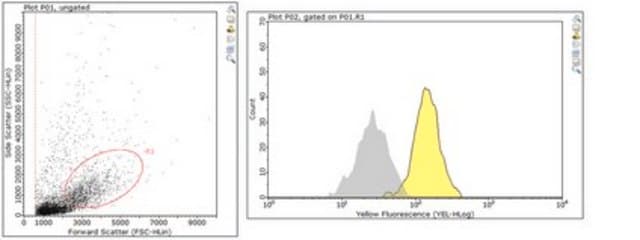Kluczowe dokumenty
11544675001
Roche
Cell Death Detection ELISA
sufficient for ≤96 tests, suitable for ELISA, kit of 1 (9 components)
Synonim(y):
ELISA
Wybierz wielkość
3210,00 zł
Wybierz wielkość
About This Item
3210,00 zł
Polecane produkty
zastosowanie
sufficient for ≤96 tests
Poziom jakości
opakowanie
kit of 1 (9 components)
producent / nazwa handlowa
Roche
metody
ELISA: suitable
temp. przechowywania
2-8°C
Opis ogólny
Specyficzność
Zastosowanie
Opakowanie
Uwaga dotycząca przygotowania
Predilute 1 ml Coating buffer conc. with 9 ml double dist. water. Shortly before use, dilute 1 ml anti-histone antibody (reconstituted) with 9 ml Coating buffer.
Washing solution
Warm the Washing buffer concentrate to 15 to 25 °C and dilute 40 ml in 360 ml double distilled water. Mix thoroughly.
Sample solution
Preparation of the sample solution depends on the cell system used and the extent of cell death.
Example: Dilute 25 μl of sample in 225 μl Incubation buffer.
Conjugate solution
Dilute 1 ml Anti-DNA-POD (reconstituted) with 9 ml Incubation buffer.
Substrate solution
Depending on the number of samples tested, dissolve 1, 2, or 3 tablets in 5, 10, or 15 ml Substrate buffer.
Allow to come to 15 to 25 °C before use.
Note: The ABTS solution is light sensitive over extended periods of time.
Storage conditions (working solution): Anti-histone
2 to 8 °C for 2 months
Anti-DNA-POD
2 to 8 °C for 2 months
Coating solution
Prepare immediately before use!
Washing solution
2 to 8 °C for 2 months
Sample solution
2 to 8 °C for 2 months
Conjugate solution
Prepare immediately before use!
Substrate solution
2 to 8 °C for 1 month, protected from light.
Rekonstytucja
Reconstitute the lyophilizate in 1 ml double-distilled water for 10 minutes.Mix thoroughly.
Anti-DNA-POD
Reconstitute the lyophilizate in 1 ml double-distilled water for 10 minutes. Mix thoroughly.
Inne uwagi
Tylko elementy zestawu
- Anti-histone antibody (clone H11–4)
- Anti-DNA-POD antibody (clone MCA-33)
- Coating Buffer
- Washing Buffer
- Incubation Buffer, ready-to-use solution
- Substrate Buffer, ready-to-use solution
- ABTS Substrate Tablet
- Microplate Modules
- Adhesive Plate Cover Foils
Hasło ostrzegawcze
Danger
Zwroty wskazujące rodzaj zagrożenia
Zwroty wskazujące środki ostrożności
Klasyfikacja zagrożeń
Eye Dam. 1 - Skin Sens. 1
Kod klasy składowania
12 - Non Combustible Liquids
Klasa zagrożenia wodnego (WGK)
WGK 3
Temperatura zapłonu (°F)
does not flash
Temperatura zapłonu (°C)
does not flash
Wybierz jedną z najnowszych wersji:
Masz już ten produkt?
Dokumenty związane z niedawno zakupionymi produktami zostały zamieszczone w Bibliotece dokumentów.
Klienci oglądali również te produkty
Nasz zespół naukowców ma doświadczenie we wszystkich obszarach badań, w tym w naukach przyrodniczych, materiałoznawstwie, syntezie chemicznej, chromatografii, analityce i wielu innych dziedzinach.
Skontaktuj się z zespołem ds. pomocy technicznej











